Cometh The Swarm: In early January 2018, Russian operators manning the extensive air defence (AD) network at Russia’s Khmeimim air base in western Syria spotted 13 incoming drones at low level. As the Russians engaged these drones with EW and SHORAD (Short Range Air Defence) systems, it was clear to them that they were witnessing a new genre of a collaborative drone attack. The Russians shot down seven drones and jammed the remaining six in the nick of time. While the Islamic State and Afghan Taliban have used drones to deliver explosive payloads, the failed attack on Khmeimim that evening was disturbing to close observers of drone warfare as the first recorded instance of a mass-drone attack by non-state actors in a combat operation. More drone attacks happened on the Russian facilities in Syria all through 2018, 2019 and 2020, with over 150 drones disabled by Russian AD in Syria till date.
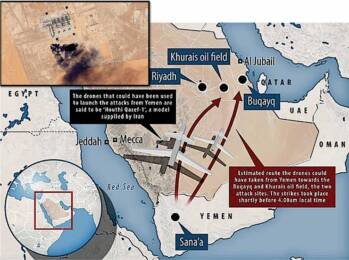
On 14 September 2019, over two dozen massed drones in two waves attacked the state-owned Saudi Aramco oil processing facilities at Abqaiq and Khurais. Analysis of satellite images of the Abqaiq facility before and after the attacks showed 19 individual strikes. What was noteworthy is that the Saudi air defence, including the potent MIM-104 Patriot and Crotale NGs missiles failed to stop these waves of drones and cruise missiles. This demonstrates how a group of drones and cruise missiles coming from multiple directions can escape undetected for long and overwhelm conventional air defences.
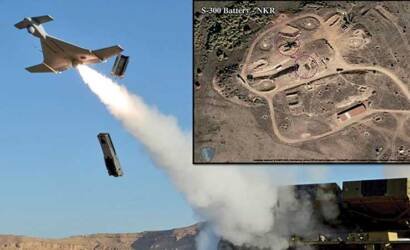
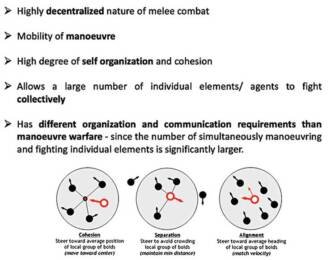
While the US and Israelis have extensively used drones in varied operational roles over the years, a glimpse of how warfare could evolve in future with the use of unmanned air vehicles (UAVs) was truly highlighted by Turkey in Syria and Libya, and by Azerbaijan against Armenia in the Nagorno-Karabakh war in 2020. The coordinated usage of armed drones and loitering munition (also known as a suicide drone or kamikaze drone) against tanks and air defence systems via electronic networks was very effective. This was especially showcased in the Azerbaijani strikes to knock down Armenian S-300 and SHORAD networks, as well as 200 plus military vehicles in the tactical battlefield area (TBA). This engagement is an order of magnitude higher from similar Russian use of UAVs in Ukraine from 2014 onwards, where networked UAVs working with Russian ground based offensive weapons systems were able to eliminate major Ukrainian army columns and supply depots. With the world taking note of these milestone events where smaller nations are exhibiting advanced warfighting capabilities, the military drone use will expand rapidly, dominated by rampant induction of surveillance and attack UAVs across the globe. Here Israel, Turkey, Russia and China are providing an effective and alternate industrial base to challenge the domination of the West in proliferation of advanced drones and allied technologies.
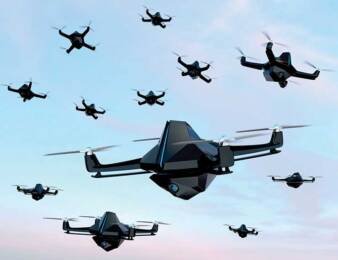
However, the drone assaults on the Khmeimim air base and Saudi oil facilities, as well as coordinated use of drones in Ukraine, Syria, Libya and Nagorno-Karabakh display early flashes of evolution in future aerial warfare towards the concept of what is known as drone swarming. In particular, the mass drone attacks on Russian forces in Syria have highlighted the rampant danger that unmanned aircraft in a group increasingly pose, even in the hands of non-state actors. Such small drone teams, collaborating together, offer a game-changing capability for not only larger nations like the US, Russia and China, but also small nations and non-state players, who will use the drone swarms in a highly asymmetric role. Significantly, low-cost unsophisticated drones working together and aiming for target saturation through numbers impose a high cost penalty on the air defence elements. While defences may be able to fend off a handful of these improvised drones executing a very loosely coordinated attack, a near peer-state competitor can field a much advanced, denser, more nimble, adaptable, and networked force.
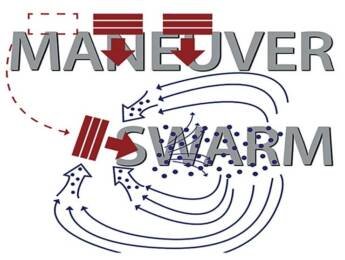
Demystifying Drone Swarming
So what exactly is a drone swarm? Swarm robotics is an approach to the coordination of multiple autonomous robots as a system which consists of a large number of mostly physical robots, controlled by minimal human intervention. These exhibit collective self-organising (SO) behaviour through interaction and cohesion between robots, as well as interaction of robots with the environment. Swarming algorithms are empowered by biological studies of swarm behaviour of insects, fishes, birds and animals. Swarming R&D across the world is focussed on development of distributed artificial swarm intelligence capability, commodification of technology for lesser cost impact and increasing state of autonomy between the agents in a swarm. While massed drones in spectacular light shows are all controlled centrally, in a true swarm each of the drones flies itself following onboard AI to maintain formation and avoid collisions with algorithms mimicking nature – there is no true leader and follower, with all agents in a swarm having their own ‘mind’ and able to undertake collective decision-making, adaptive formation flying, and self-healing. The benefit of such a swarm is that if one drone drops out — and a few appear to crash — the group can rearrange itself to continue undertaking the mission till the last UAV in air.
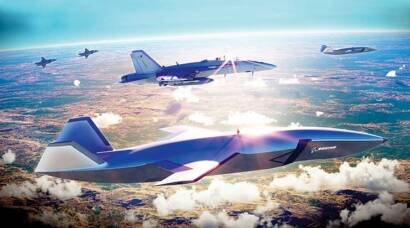
Over time, as militaries have incorporated greater communications, training and organisation, they were able to fight in an increasingly sophisticated manner, leveraging more advanced doctrinal forms, with each evolution superior to the previous. Today militaries predominantly conduct manoeuvre warfare. Here swarming would be the next evolution in warfare – with the swarms exhibiting the decentralised nature of melee combat, along with the mobility of manoeuvre warfare. They have varied levels of autonomy and artificial intelligence. The autonomy extends military reach into the well defended battle space, operating with greater range and persistence than manned systems; while artificial intelligence ensures dangerous and suicidal missions, thus allowing more daring concepts of operation (CONOPs). Both provide greater success in face of increased threat levels and rapid penetration of contested airspace.
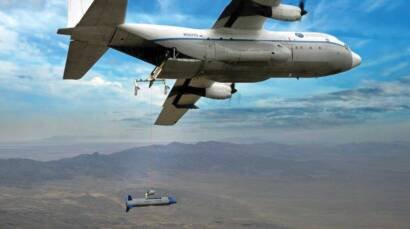
This switch to the unmanned is happening all across the world. And the most preferred route for delivery of kinetic and non-kinetic payloads is via air. Traditionally, in airpower-heavy militaries like the US, air operations have relied on increasingly capable multi-function manned aircraft to execute critical combat and non-combat missions over the decades. However, improved adversarial abilities to detect and engage these aircraft from longer ranges are driving up the costs for vehicle design, operations and replacements. Thus the ability to send large numbers of small unmanned air systems (UASs) with coordinated and distributed capabilities could provide militaries across the world with improved operational footprints at a much lower cost. These, embedded with manned elements, will effectively saturate adversary targets as a ‘system of systems’. Here, Manned and Unmanned Teaming (MUM-T) acts as a force-multiplier with autonomy and collaboration and the warfighter’s role transforming to commanding, rather than controlling a swarm. Once unleashed, an armed and fully autonomous drone swarm (AFADS) with distributed AI will locate, identify, and attack targets without human intervention. While new technologies and in particular AI and edge computing will drive drone swarms, the key element is still going to be the swarming software. Collaborative autonomy with emergent swarming software has developed rapidly and is proliferating in all segments of drone swarm research and testing, as well as next generation unmanned loyal wingman programs.
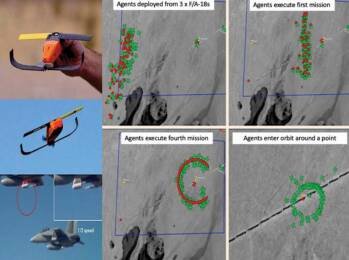
Military Swarming Across the World
The US is the world leader in swarm technology and has commenced a host of swarming UAV and munition initiatives. It demonstrated the Perdix swarm in 2017. A trio of F/A-18 Super Hornet fighters release a total of 103 Perdix drones in air. The drones formed up at a preselected point and then headed out to perform four different missions. Three of the missions involved hovering over a target while the fourth mission involved forming a 100-meter-wide circle in the sky. The demo showed Perdix’s collective distributed intelligence, adaptive formation flying, and self-healing abilities.
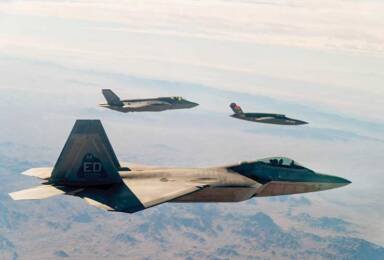
There are many uses for such a drone swarm. The drones could be released by fighters to provide reconnaissance for troops on the ground, hunting enemy forces and reporting their location. They could also jam enemy communications, form a wide-area flying communications network, or provide persistent surveillance of a particular area. They could be loaded with small explosive charges and attack individual enemy soldiers. In air-to-air combat, they could spoof enemy radars on aircraft, ground vehicles, and missiles by pretending to be much larger targets.
The Defense Advanced Research Projects Agency (DARPA) of the US has also showcased the X-61A Gremlin air launched drones. The idea behind DARPA’s Gremlins program is to turn cargo aircraft like the C-130 into a mother-ship capable of launching and retrieving swarms of small drones. This would open up a world of possibilities to the military, allowing deployment of swarms of small, inexpensive, reusable drones with different sensors and payloads from legacy aircraft. The US Navy and Marine Corps’ Low-Cost UAV Swarming Technology (LOCUST) program, which fires small UAVs from a tube-based launcher to conduct a varied class of missions, is another swarm development underway. The US Army is also working on drone swarms and Reinforcement Learning (RL) based AI algorithms for use in TBA in multi-domain battle scenarios, where swarms will be dynamically coupled and coordinated with heterogeneous mobile platforms to overmatch enemy capabilities.
The US is also experimenting with collaborative smart munition delivery using the Cluster UAS Smart Munition for Missile Deployment where the payload can be launched and deployed from a GMLRS or ATACMS platform. The payload consists of multiple deployable smart UAVs capable of delivering small explosively formed penetrators (EFP) to designated targets. The USAF’s Golden Horde – part of the Vanguard initiative to develop next generation offensive technologies – will network munitions like Small Diameter Bombs (SDB) together to operate cooperatively after launch according to a set of predetermined rules and thus increase effectiveness.
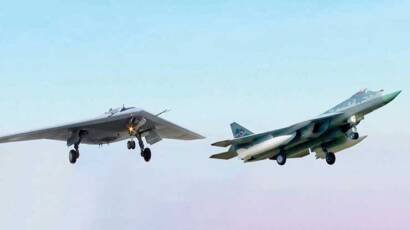
Further, the USAF’s ‘Skyborg’ initiative aims to design and deploy an artificially intelligent fleet of loyal wingman unmanned combat air vehicles (UCAV). The Kratos XQ-58A, the Sierra 5GAT & Boeing’s ATS are undergoing development trials as part of the Skyborg initiative. These will operate as swarms in MUM-T mode, flying at high speed alongside fighter jets and carrying missiles, ISR and EW technology. The aircraft will be expected to target and shoot down enemy aircraft and survive against SAMs in contested airspace.
On the other hand, the UK may have the world’s first operational swarm drone unit by the middle of 2021 to perform tasks including suicide missions inside enemy lines and overwhelming adversary air defences. The Royal Air Force’s No. 216 squadron has been tasked to test and deploy future drone swarm capability. The UK has also announced the Project Mosquito, which is a part of the RAF’s Lightweight Affordable Novel Combat Aircraft (LANCA) unmanned loyal wingman program. This aims to fly a networked unmanned wingman by 2023. The UK has also tested an autonomous swarm of drones each carrying a variant of Leonardo’s BriteCloud expendable active decoy as an electronic warfare payload. Using the BriteClouds, which contain electronic warfare jammers, the drones were able to launch a mock non-kinetic attack on radars acting as surrogates for a notional enemy integrated air defence network.
Airbus in France also has demonstrated for the first time collaborative remote carrier (RC) wingman technology towards the Future Combat Air System (FCAS)/Systeme de Combat Arien du Futur (SCAF) program.
The Russians have had extensive experience operating collaborative drones and countering the same in Ukraine and Syria. The last decade has upscaled UAV efforts in Russia and it aims to induct a large component of robotic vehicles in its military by 2025. It has an initiative called the ‘Flock 93’, which aims to operationalise a high-density swarm in coordinated saturation strike missions. Originally proposed by the Zhukovsky Air Force Academy and private industry, the concept involves simultaneously launching more than a 100 drones, each armed with a 5.5 pound warhead. The Russians have also tested the S-70 Okhotnik UCAV in loyal wingman roles with its fighter jet fleet to penetrate adversary air space. A lighter loyal wingman project with the designation Grom has also been unveiled by Russia in 2020. The Russians are aware of the lead in swarm autonomy which the US and China have, and are engaged in R&D and product development initiatives to close the gap in these niche areas in the coming decade.
The Chinese are the closest in matching the high-density drone swarm capability of the US and in many ways are replicating the US R&D initiatives with development of AI empowered autonomous drone swarms. Recently, the China Academy of Electronics and Information Technology (CAEIT) tested a 48 x tube launched drone swarm of CH-901 UAVs. The CAEIT in the past has demonstrated a 200 unit drone military swarm in 2017. Chinese companies have also demonstrated impressive swarms of 1,000 plus drones using quad-copter-type drones for large public displays, which however are ground-controlled and do not have distributed intelligence. The Chinese are undertaking integration of their existing UAV fleet in a robust collaborative autonomy role with the military. It also has a loyal wingman AVIC 601-S ‘Anjian’ under development, which will operate with the fourth and fifth generation PLAAF fighters platforms. Whatever the goals and state of China’s drone swarms developments are, its capability and potential threats are definitely real and evolving rapidly.
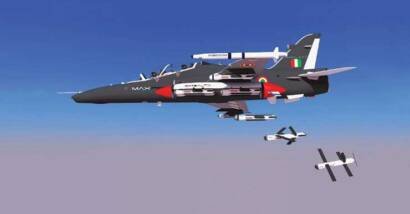
Other nations developing swarm technology are Israel, where details on such initiatives are closely guarded. However, given the nature of Israeli operational UAV usage over the years, there are reasons to believe that it is matured and has been deployed on its fleet of UAVs and loiter munitions, some of which have been proven disabling Syrian AD networks. Interestingly, IAI (Israel Aerospace Industries) offers a smartphone-based swarming command and control capability for worldwide sales.
Turkey, which has proven mature MALE UAV capabilities in Syria and Libya through locally made platforms like the TB-2, also has various swarm drone initiatives. Primary amongst them is the Kargu quad copter, which can be employed in kinetic attack roles in the TBA. Iran is another middle-eastern nation that has used drones in groups operationally. Iran has embraced unmanned aerial vehicles (UAVs) as a major pillar of its military strategy. Iranian authorities use drones for two main purposes: surveillance and attack. Iran has the ability to conduct missions over the horizon and in most weather conditions. These include drones with the ability to drop bombs or launch missiles and return to base and ‘kamikaze’ drones that seek targets of opportunity. Iranian authorities have had more success with the latter as was visible in the Saudi oilfield strikes in 2019, where Iranian made drones and cruise missiles were used. While baseline collaborative autonomy may be available, both Iran and Turkey may not have true distributed intelligence ability amongst their swarms. But their efforts are a clear indication of how the technology is maturing and proliferating.
India’s Swarm Drone Odyssey
In India, the Indian Air Force has been pioneering swarm drone research & development with its Meher Baba initiative since 2019. This is geared towards in-depth humanitarian assistance and disaster relief (HADR) operations. On the other edge of the spectrum, the Indian Army showed off a mature offensive capability with a swarm of 75 autonomous drones with distributed intelligence and edge computing, destroying a variety of simulated targets with kamikaze attacks during India’s Army Day parade in New Delhi in January 2021.
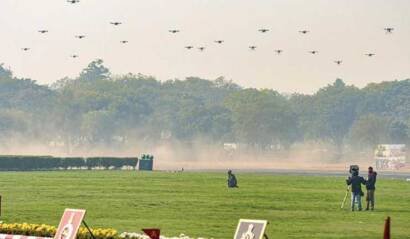
In the demo, scout drones investigated the targets, then attack and mother-ship drones released payloads and explosive-laden kamikaze drones, which carried out the attacks. Western commentators noted several significant features of the Indian Army demonstration comparing it to the US effort around drones, which often emphasises a large homogenous swarm. They pointed out India’s work, which showcased a heterogeneous swarm effort for the first time in the world in public using a ‘system of systems’ approach while employing a large variety of low cost drones, as the probable way forward in this domain.
The Hindustan Aeronautics Limited (HAL) in India has unveiled the Air Launched Flexible Asset (ALFA-S) air launched swarming drone system as part of its next generation Combat Air Teaming System (CATS). This is a unique program that utilises a network of air launched remote carriers and swarming units to penetrate contested airspace. The USAF’s Air Force Research Laboratory is collaborating on aspects of the ALFA-S with India. Another component of HAL’s CATS program is the Warrior loyal wingman asset. This is geared for air defence and offensive strike missions and will be employed in a MUM-T role with India’s Tejas LCA and the upcoming AMCA fifth generation combat aircraft. What is noteworthy is that India is well driven by the power of indigenous research and the government’s Make in India push to embrace disruptive technologies that are at par with similar efforts happening across the world.
Drone Swarms: The Future is Now

It is pertinent to note that while drone swarms may not be ready as an end state ‘product’, proliferation of basic swarming technology is inevitable in the coming decade across the world. Here, advances in drone swarming, which is the next evolution of robotic warfare are mostly classified, though governments have given glimpses of their progress over the years. The question is not if, but when and where drone swarms will be utilised as part of a mature concept of operations (ConOps).
Swarming ConOps, a red herring for most nations, can only be matured with clinical and robust field trials utilising hundreds of heterogeneous swarming units. It is this ‘scale and associated cost’ borne by the end user that will determine a dynamic adoption, meaningful operationalisation and acceptable timelines of induction towards exploited usage of swarms as true agents of warfare. It is here that countries like the US and China have a distinct advantage over the rest of the world towards deployment of swarm drone capabilities across the spectrum of missions, at a scale that will tilt the balance in their favour in the digitally contested airspace of tomorrow.
–The writer is an Ex IAF Mirage 2000 fighter pilot who writes on Aerospace & Defence subjects





